As an Amazon Associate KitchenwareSets.com earns from qualifying purchases.
French Countryside Kitchen Ideas You Can Copy on Any Budget
Have you found yourself scrolling through endless photos of dreamy, rustic kitchens, sighing over the effortless charm of a French countryside aesthetic? You can almost smell the lavender and fresh-baked bread, can’t you? It’s a style that feels both elegant and incredibly welcoming, a perfect blend of rustic comfort and sophisticated grace.
But then, reality sets in. You look at the gorgeous stone floors, the vintage-style ranges, and the custom cabinetry, and a single thought pops into your head: that must cost a fortune. It’s easy to believe that achieving this timeless look requires a budget the size of a small chateau, leaving you feeling like it’s an unattainable dream.
Here’s the secret: a French Country kitchen is an aesthetic built on charm and character, not just expensive materials. It beautifully balances rustic warmth with refined elegance, emphasizing natural textures, soft, muted colors, and a lived-in, collected feel. The best part? This timeless style can be achieved on any budget by focusing on key, high-impact elements like paint, hardware, and textiles.
Dreaming of a French Country Kitchen Without the Chateau Price Tag?
The allure of a French country kitchen lies in its ability to feel both sophisticated and utterly unpretentious. It’s a space designed for living, cooking, and gathering. In my experience helping homeowners create their dream spaces, I’ve learned that the most beautiful transformations don’t always come with the biggest price tags. It’s about a thoughtful approach, focusing on the feeling you want to create. This guide is all about giving you practical, beautiful, and budget-friendly ideas to bring that rustic, elegant dream to life in your own home.
What is a French Country Style Kitchen at its Core?
At its heart, a classic French country kitchen combines rustic elements like weathered wood and stone with elegant details. Its key features include a soft, nature-inspired color palette, often a large farmhouse table for gathering, and beautiful displays of practical items like copper cookware and vintage pottery. It’s a style defined by a graceful balance.
Think of it as the intersection of farmhouse practicality and Parisian chic. The foundational principle is this blend of “rustic” and “chic.” To break it down, here are the core characteristics:
- Natural Materials: This is non-negotiable. The style leans heavily on organic textures. You’ll see lots of wood (especially weathered or reclaimed oak), stone (like limestone and terracotta), wrought iron for lighting and hardware, and gleaming copper for pots and pans.
- Soft, Muted Color Palette: The colors are pulled directly from the Provençal landscape. Think creamy whites, warm beiges, soft greys, and faded accent colors like French blue, sage green, pale yellow, and lavender.
- A “Lived-In” Feel: Nothing is too perfect or precious. A true French country kitchen looks as though it has been lovingly used and collected over generations. Scratches on a wooden table or a collection of mismatched ceramic pitchers add to its authentic charm.
- Functional Elegance: Every item tends to have a purpose, but that purpose is executed with beauty. A set of copper pots isn’t just for cooking; it’s hung on a rack to become a stunning piece of wall decor. A simple ceramic jug holds wooden spoons by the stove but could just as easily hold a bouquet of wildflowers.
7 French Countryside Kitchen Ideas You Can Start This Weekend
Ready to roll up your sleeves? You don’t need a full-scale demolition to start seeing a change. The beauty of this style is that it can be layered into your existing kitchen with smart, impactful updates. I’ve curated these seven ideas based on what provides the biggest transformation for the least amount of time and money. These are achievable, weekend-friendly projects that will get you well on your way to your dream kitchen.
Here’s a little inspiration to get you started:
1. Master the Soft Color Palette with Paint
The single most impactful and cost-effective way to create a French country feel is with paint. The right color on your walls or cabinets can instantly transform the entire mood of the room, shifting it from generic to charming.
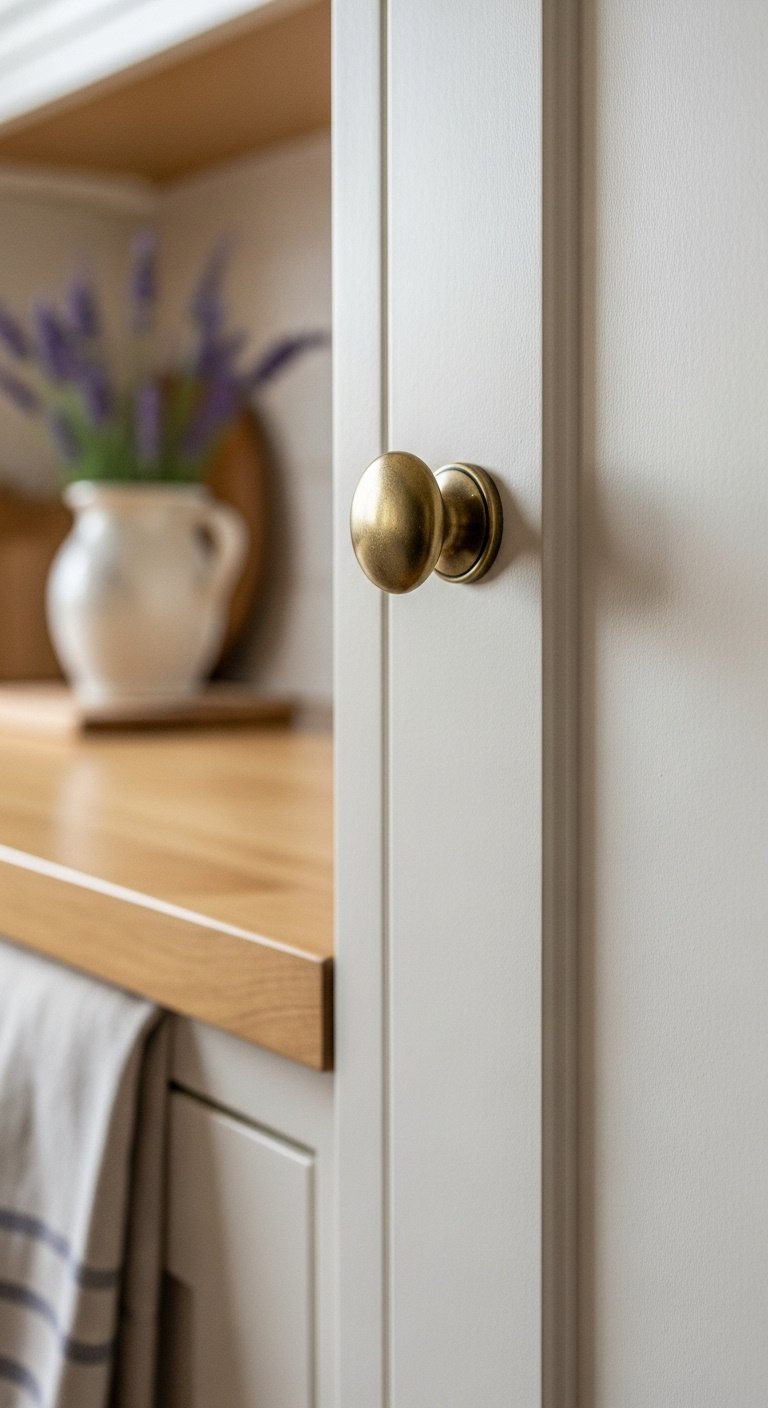
This is a project you can absolutely tackle yourself.
- Materials Needed:
- High-quality interior paint (e.g., Benjamin Moore’s White Dove, Sherwin Williams’ Canvas Tan)
- Primer
- Paint rollers and brushes
- Painter’s tape
- Drop cloths
- Fine-grit sandpaper
- Step-by-Step Directions:
- Prep Your Space: Your prep work is the key to a professional-looking finish. Clear everything off your countertops and floors. Cover everything you don’t want painted with drop cloths. Use painter’s tape to get clean lines around trim, windows, and cabinets.
- Clean & Sand: Gently sand cabinet doors and walls to scuff up the surface. This helps the primer and paint adhere. After sanding, wipe everything down with a damp cloth to remove any dust and grime.
- Prime First: Don’t skip the primer! It covers old colors, blocks stains, and ensures your new color looks rich and even. Apply one solid coat and let it dry completely according to the can’s instructions.
- Apply Color: Now for the fun part. Using a roller for the large, flat surfaces and a quality brush for the details, apply your chosen French country color. Let the first coat dry, then apply a second coat for a beautiful, durable finish.
Pro-Tip: For a more authentic, aged look on walls, consider a lime wash or a paint with a chalky finish. It adds a subtle, velvety texture that beautifully mimics the look and feel of old-world plaster walls you’d find in a Provençal farmhouse.
Pin this color inspiration for your dream kitchen makeover!
2. Give Cabinets an Instant French Makeover
You can dramatically alter your kitchen’s style by updating your existing cabinets without replacing them. Simple changes to hardware or even removing a few doors can make a world of difference and infuse that essential rustic character.
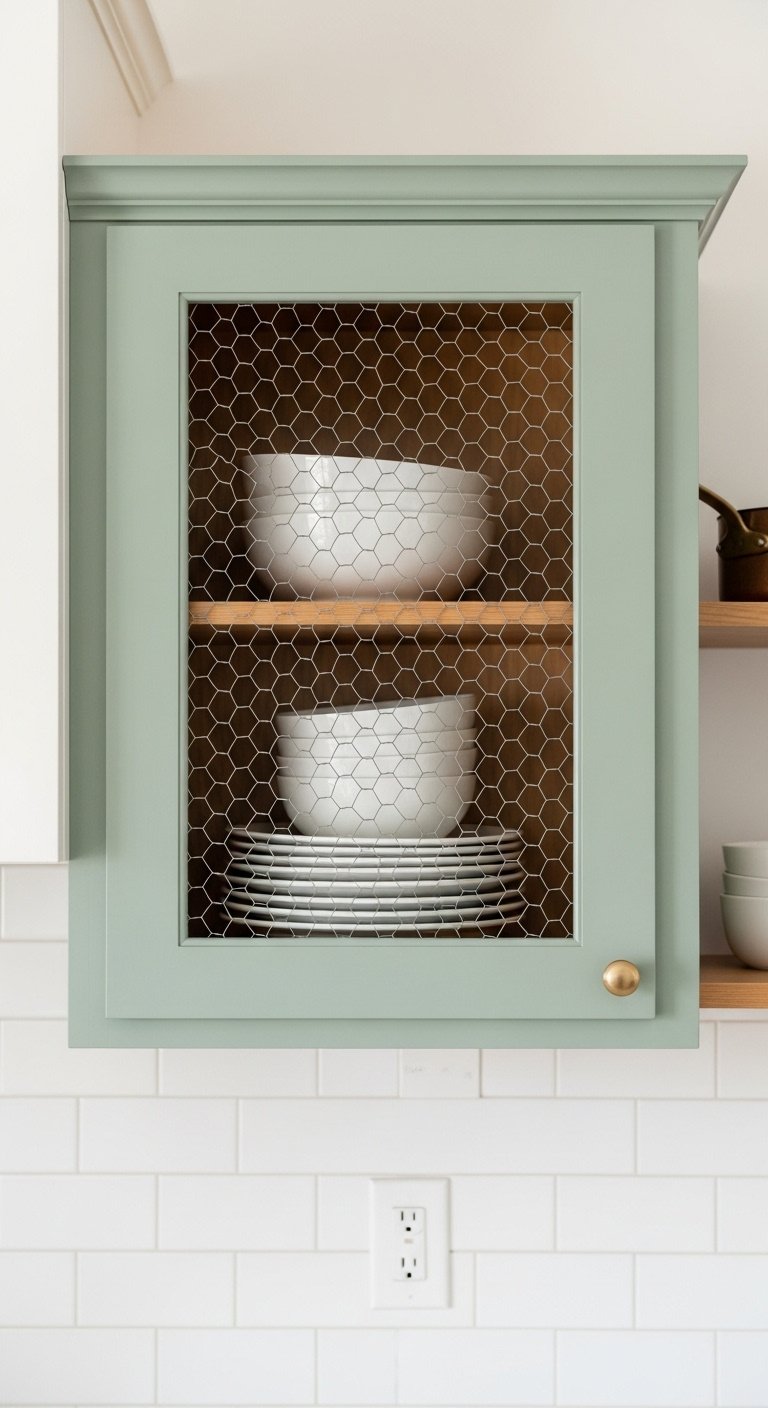
Focus on these small but mighty changes.
- Materials Needed:
- New cabinet hardware (look for antique brass, pewter, or wrought iron pulls/knobs)
- Screwdriver
- Wood filler (if the new hardware holes don’t align with the old ones)
- Optional: Chicken wire, glass panels, a staple gun
- Step-by-Step Directions:
- Remove Old Hardware: This is the easy part. Simply unscrew the existing knobs and pulls from your cabinets.
- Install New Hardware: If you’re lucky, the screw holes will align perfectly. If not, fill the old holes with a dab of wood filler. Once it’s dry, sand it smooth, touch it up with paint, and then drill new holes to fit your new hardware.
- Create Open Shelving (Optional): For a lighter, more airy look, carefully remove the doors from one or two upper cabinets. Fill and paint the old hinge holes. Now you have the perfect spot to style your favorite white dishes, glassware, and cookbooks.
- Add a Rustic Panel (Optional): This is one of my favorite tricks. Carefully remove the central wood panel from a cabinet door (a router can help with this). Then, using a staple gun, staple a piece of chicken wire to the inside of the frame for an instant, rustic farmhouse look.
Lesson Learned: From my own experience, always buy one extra piece of hardware. It’s so common for a screw to be faulty or for a piece to get scratched during installation. Having a spare on hand saves you an annoying trip back to the store mid-project.
Love this look? Save it to your ‘DIY Kitchen’ board!
3. Incorporate a Rustic “Workhorse” Island
A central island is often the heart of a kitchen, but a vintage wooden table can serve as a stunning and affordable alternative to a custom-built island. It provides workspace, a gathering spot, and an immediate dose of rustic, found-character.
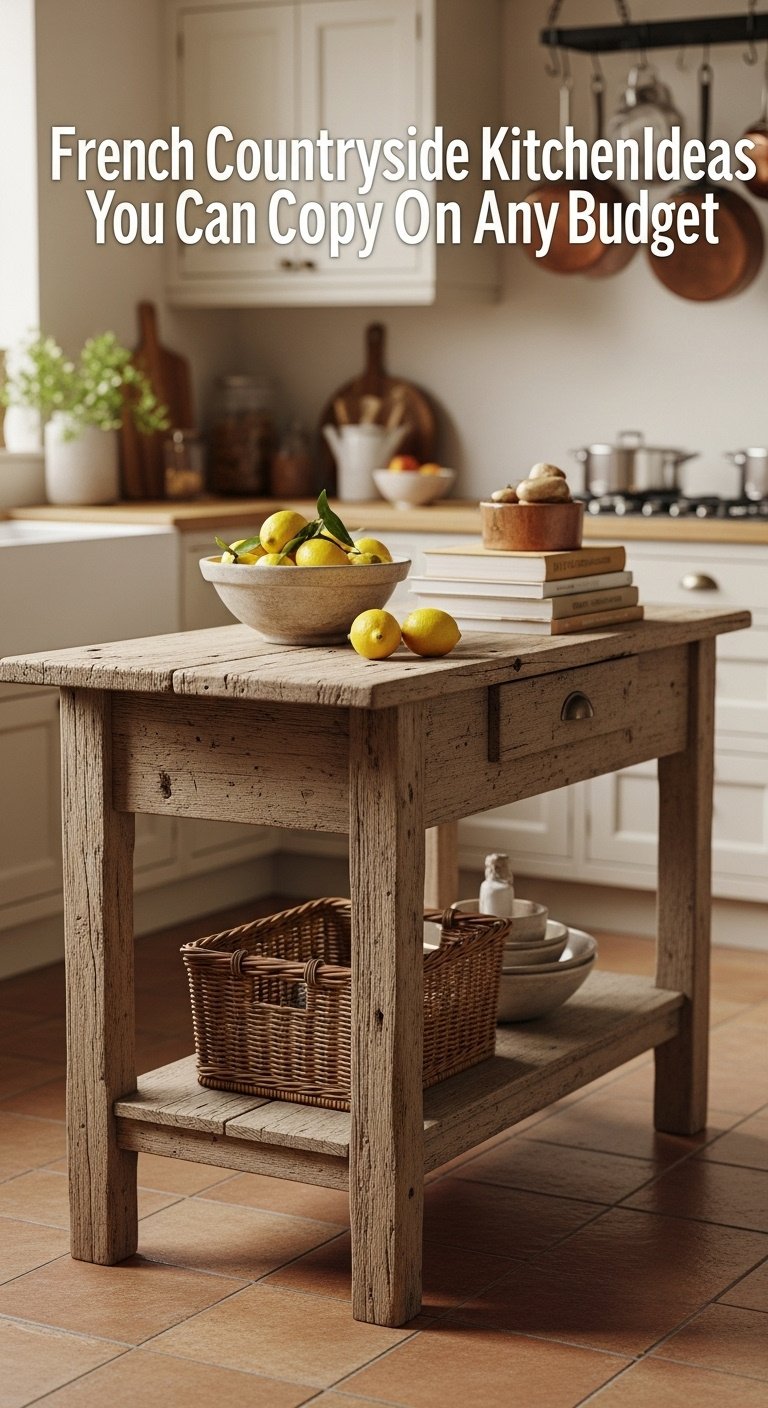
The hunt is part of the fun!
- Materials Needed:
- A vintage wooden table, console, or old dresser
- Sandpaper (medium to fine-grit)
- Optional: Chalk paint and clear furniture wax
- Optional: A simple towel bar or S-hooks
- Optional: Locking caster wheels for mobility
- Step-by-Step Directions:
- Source Your Piece: Your treasure hunt begins! Scour local thrift stores, flea markets, and online marketplaces like Facebook Marketplace for a sturdy wooden table with character. Look for interesting details like turned legs or a beautifully worn top.
- Clean and Prep: Give your piece a thorough cleaning. If you want a more distressed look, you can lightly sand the edges and corners to reveal some of the wood underneath the existing finish.
- Paint or Seal: For a classic painted look, apply two coats of chalk paint (which requires minimal prep) and seal it with clear wax for durability. If you love the natural wood, simply apply a food-safe wood conditioner or sealant to protect the top.
- Add Functionality: Make it work for you! Install a simple towel bar on one end. Add a few S-hooks for hanging utensils or small pans. For extra flexibility, you can add locking caster wheels to the legs to make it mobile.
Pro-Tip: Don’t worry about perfection. Seriously. Dings, scratches, and even old watermarks on a found piece are not flaws—they are the story. They add to the authentic, “lived-in” charm that is absolutely central to the French country aesthetic.
Share this clever repurposing idea with a friend!
4. Hang a Statement Light Fixture
The right lighting, particularly a wrought iron chandelier, acts as the jewelry of a French country kitchen. It elevates the entire space, adding a touch of rustic elegance and a warm, inviting glow that makes everyone want to linger.
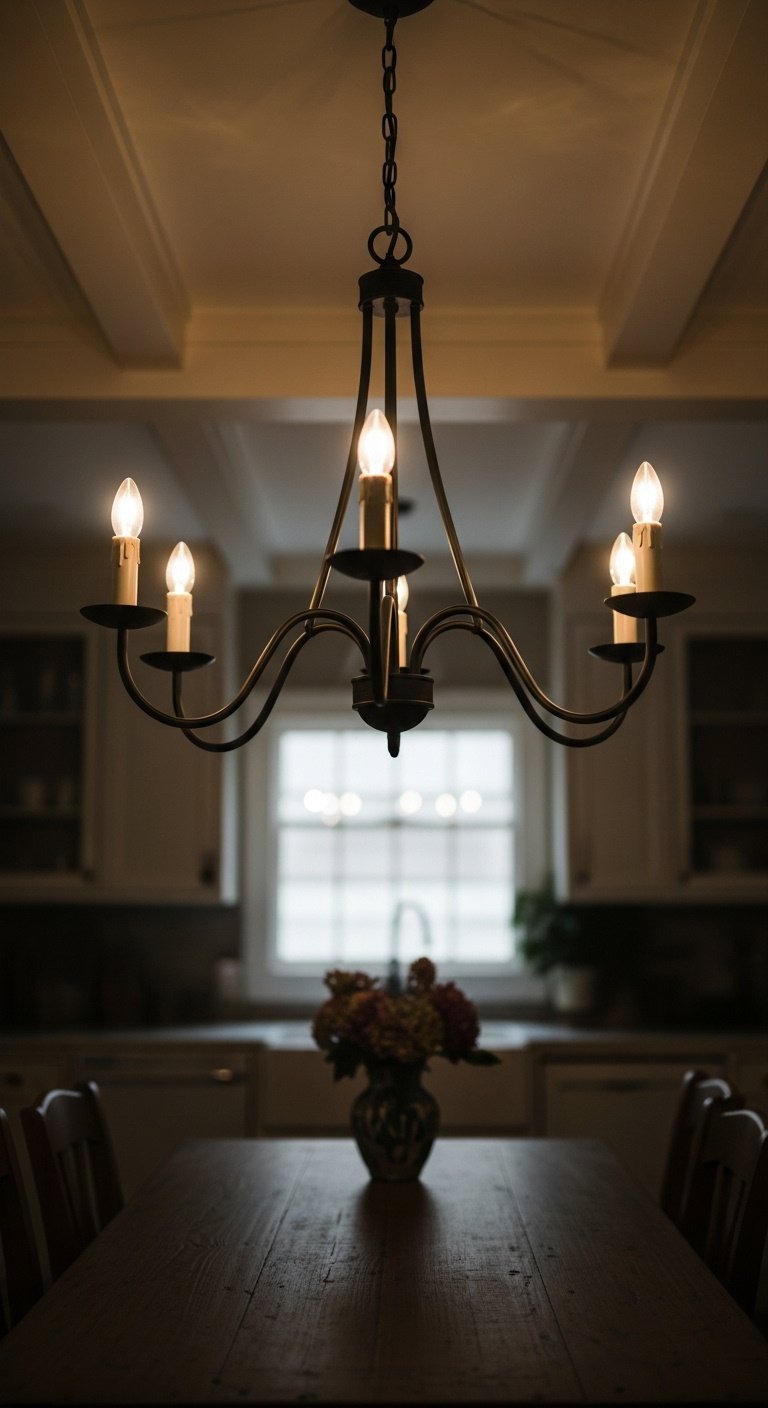
While it might seem intimidating, changing a light fixture is a manageable DIY.
- Materials Needed:
- New light fixture (chandelier or pendant style)
- Sturdy ladder
- Voltage tester
- Wire strippers and a screwdriver
- Wire nuts
- Step-by-Step Directions:
- SAFETY FIRST: This is the most important step. Go to your circuit breaker and turn off the power to the light fixture you’re replacing. Use a voltage tester on the wires to confirm there is absolutely no power running to them.
- Remove the Old Fixture: Carefully unscrew the canopy (the part that sits flush against the ceiling) of your old fixture and lower it. It’s very helpful to have a second person to hold the fixture while you disconnect the wires.
- Install the New Bracket: Your new light will come with instructions and a mounting bracket. Follow them carefully to install the new bracket to the electrical box in the ceiling.
- Connect the Wires: Have your helper hold the new fixture up while you connect the wires—usually, it’s black to black (hot), white to white (neutral), and the bare copper wire to the green ground screw. Secure each connection tightly with a wire nut.
- Attach the Fixture: Gently push the wires back into the electrical box and secure the new fixture’s canopy to the mounting bracket. Install your light bulbs, turn the power back on at the breaker, and admire your work!
Lesson Learned: Before you buy, check the weight of your new chandelier. If it’s significantly heavier than the fixture you’re replacing, you may need to install a new, heavy-duty electrical box in the ceiling for safe support. When in doubt, this is a quick and worthwhile job for a professional electrician.
Pin this lighting idea to brighten up your kitchen design board!
5. Soften the Space with Classic French Textiles
Introducing soft fabrics in classic patterns is a simple way to add authentic French country charm and balance the hard surfaces of a kitchen. Think linen, cotton, and iconic patterns like toile or simple stripes.
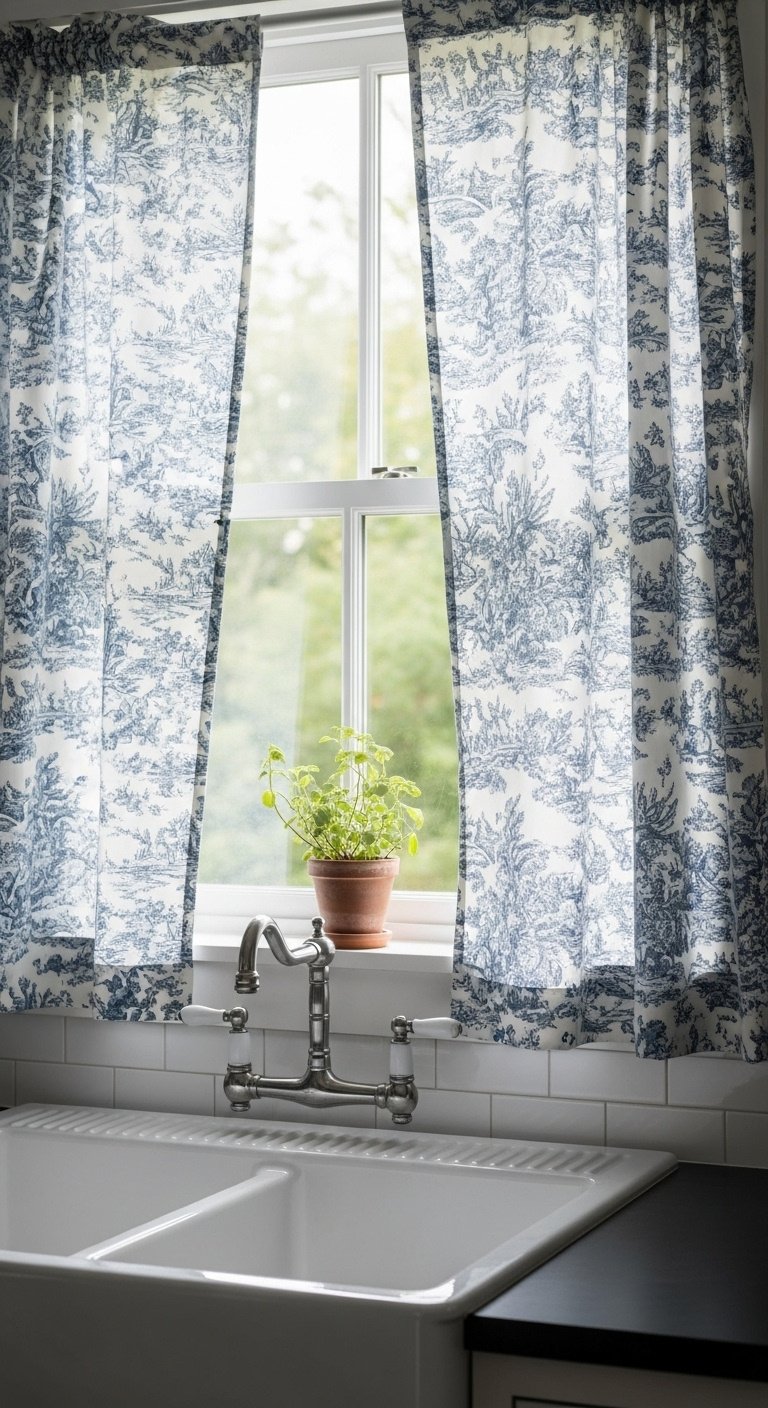
Even if you don’t sew, you can easily add this layer of softness.
- Materials Needed:
- Fabric of your choice (linen, cotton, toile, or a soft stripe)
- Tension rod for no-drill cafe curtains
- Iron-on hem tape (the no-sew secret weapon!)
- Measuring tape, scissors, and an iron
- Step-by-Step Directions (for No-Sew Cafe Curtains):
- Measure Your Window: Measure the inside width of your window frame to get the right size tension rod. Then, decide on the height you want your curtains—typically, they cover the bottom half of the window for privacy while still letting in light.
- Cut Your Fabric: You’ll need two panels. The width of each panel should be about 1.5 times half your window’s width (this gives them a nice, gathered look). The height should be your desired final height plus about 4 inches for the hems.
- “Hem” the Sides and Bottom: This is where the magic happens. Fold the side and bottom edges over by 1/2 inch and press them flat with an iron. Then, fold them over again by another 1/2 inch and press. Secure this hem using the iron-on hem tape according to its package directions.
- Create the Rod Pocket: For the top edge, fold it down 1/2 inch and press. Then, fold it down a larger 2 inches and press again. Use the hem tape to secure only the very bottom edge of this fold, leaving the top open. This creates a pocket for the rod to slide through.
- Hang: Simply slide the tension rod through the pocket of each panel, adjust the rod to fit snugly in your window frame, and you’re done!
Pro-Tip: Don’t limit your use of textiles to just the windows. The cozy, layered look comes from using them in multiple places. Drape a beautiful linen towel over the front of your sink, add a cushion with a floral print to a wooden chair, or use a striped linen runner on your island or table.
Save this simple DIY project for a cozy kitchen update!
6. Display Your Wares with Open Shelving
The use of open shelving to display everyday items is a hallmark of the French country style. It’s practical, beautiful, and forces you to be thoughtful about the items you own, turning simple plates and glasses into a curated display.
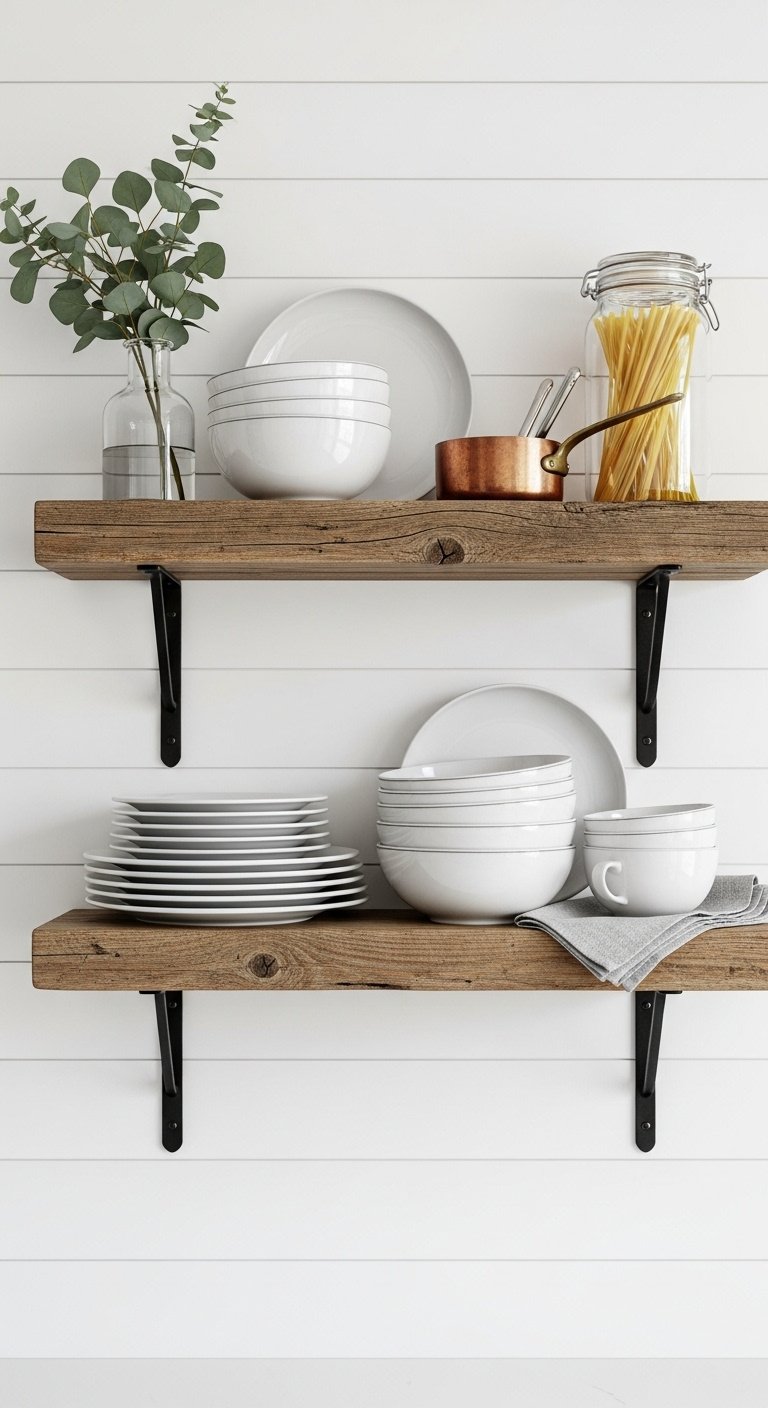
Installing simple, rustic shelves is a straightforward project.
- Materials Needed:
- Reclaimed wood planks or thick pine boards from a hardware store
- Decorative shelf brackets (look for wrought iron or distressed metal styles)
- A stud finder, level, drill, and screws
- Wood stain or paint (optional)
- Step-by-Step Directions:
- Prep Your Shelves: Cut your wood planks to your desired length. Give them a good sanding to smooth any rough spots. If you like, apply a wood stain or a coat of paint and let it dry completely.
- Locate Studs: This is a crucial step for safety and stability. Use a stud finder to locate the vertical wood studs in your wall where you plan to hang the shelves. Mark their locations lightly with a pencil.
- Install Brackets: Use your level to make sure your pencil marks for the brackets are perfectly even. Drill pilot holes into the studs, then securely screw the brackets into the wall.
- Attach Shelves: Place your wooden plank on top of the installed brackets. Secure it by screwing up through the holes in the bracket into the bottom of the shelf.
- Style Your Shelves: Now, the artful part. Arrange your everyday items like white plates, bowls, and glassware. Intersperse them with more decorative pieces like small plants in terracotta pots, ceramic pitchers, or your favorite cookbooks.
Pro-Tip: When styling your shelves, stick to a cohesive color palette (like all-white dishes or clear glassware) to prevent them from looking cluttered and chaotic. A designer trick is to group items in odd numbers (like threes) and vary the height and texture of the objects for maximum visual interest.
Get inspired! Pin this shelf styling idea for your own kitchen.
7. Accessorize with Found & Foraged Charm
The final layer of a French country kitchen comes from its accessories, which should feel collected and personal. This is where you can truly let your personality shine by displaying items that are both useful and beautiful.

Think of your kitchen’s surfaces as a canvas for charming vignettes.
- Materials Needed:
- Thrift store and flea market finds (ceramic pitchers, old scales, vintage mirrors, wooden boards)
- Woven baskets of various sizes
- Fresh or dried herbs like lavender and rosemary
- Small potted plants
- A wall-mounted pot rack
- Step-by-Step Directions:
- Hang a Pot Rack: Install a simple pot rack on an empty wall and hang your best-looking pots and pans. This is especially effective if you have any copper, cast iron, or enamel pieces. It’s practical storage that doubles as art.
- Group Collections: Similar items grouped together create a much bigger impact. Lean a collection of vintage wooden cutting boards against your backsplash. Group three white ceramic pitchers of different sizes on an open shelf or your countertop.
- Bring Nature In: This is essential for the “countryside” feel. Place a small vase of fresh flowers from your garden or a bundle of dried lavender in a pitcher. Keep small potted herbs like basil or rosemary on a windowsill for fresh flavor and natural beauty.
- Use Baskets for Storage: Baskets add wonderful texture. Use larger woven baskets on the floor to hold root vegetables like potatoes and onions. Place smaller baskets on shelves or a countertop to stylishly corral clutter like mail or keys.
Lesson Learned: The most authentic and beautiful French country kitchens look like they’ve been curated over time, not decorated in a weekend. My best advice is to enjoy the process. Relish the hunt for unique pieces at flea markets and antique shops that tell a story and truly speak to you.
What’s your favorite accessory? Save this post for decor inspiration!
Key Takeaways: Your Quick Guide to a French Countryside Kitchen
Feeling inspired? It’s amazing what a few thoughtful changes can do. Here’s a quick recap of the most impactful, budget-friendly strategies to get you started:
- Embrace Paint: The fastest and most affordable way to transform your kitchen is with a soft, muted color palette on walls and cabinets.
- Update Hardware: Swapping basic cabinet knobs for antique brass or wrought iron hardware provides an instant, high-impact upgrade.
- Shop Secondhand: Find your centerpiece—like a rustic table for an island—at flea markets and thrift stores for authentic character without the high cost.
- Focus on Textiles: Soften the hard surfaces of a kitchen with linen curtains, toile patterns, and striped tea towels.
- Decorate with Purpose: Use functional items like copper pots, white dishware, and woven baskets as your primary decor.
People Also Ask About French Countryside Kitchens
It’s natural to have questions when diving into a new style. Here are answers to some of the most common queries we see. Updated for 2025.
What are the best colors for a French country kitchen?
The best colors for a French country kitchen are drawn directly from nature. A neutral base of creamy whites, warm beiges, and soft grays is a classic starting point. For accent colors, choose muted and faded shades like French blue, pale sage green, soft butter yellow, or lavender. These timeless colors work together to create the warm, serene, and inviting atmosphere that is so characteristic of the style.
What is a French country style kitchen?
A French country style kitchen is a beautiful blend of rustic charm and understated elegance. It prominently features natural materials like wood and stone, soft color palettes, and practical-yet-beautiful decor such as copper pots and vintage china. The overall feeling is warm, lived-in, and welcoming, perfectly combining farmhouse functionality with sophisticated details.
How can I make my modern kitchen more French country?
You can introduce French country elements into a modern kitchen without a full renovation. Start with the accessories. Swap sleek, modern cabinet hardware for antique brass or iron. Add rustic touches like a vintage wooden cutting board, display a few copper pans, and incorporate soft linen textiles like a striped runner or tea towels. Painting your cabinets or even just the island a soft, muted color will also make a significant and immediate impact.
Final Thoughts
Creating a French countryside kitchen is less about a strict set of rules and more about capturing a feeling—one of warmth, comfort, and timeless beauty. It’s a journey of collecting pieces you love and creating a space that invites people to gather and stay awhile. Remember that a beautiful, inviting kitchen is absolutely achievable on any budget. It’s about creativity, patience, and enjoying the process of making a house truly feel like a home.
What’s the first project you’re going to tackle to bring a touch of the French countryside into your home?
